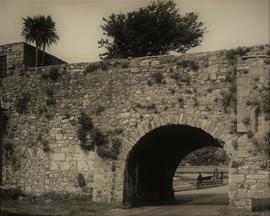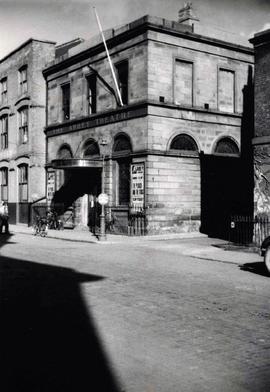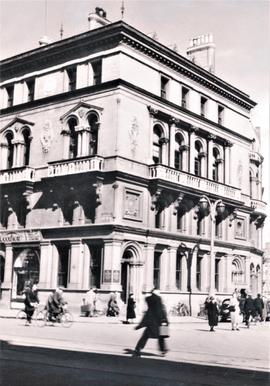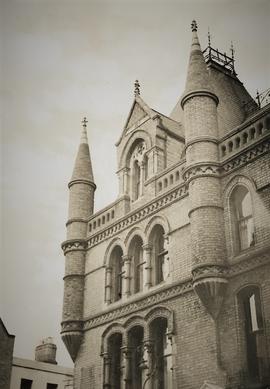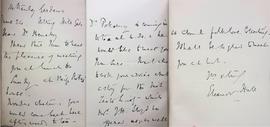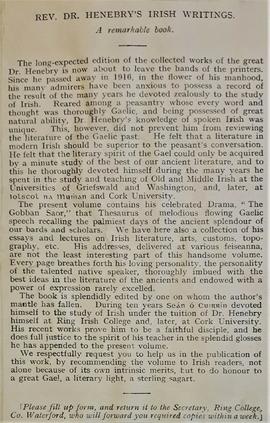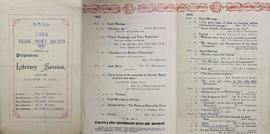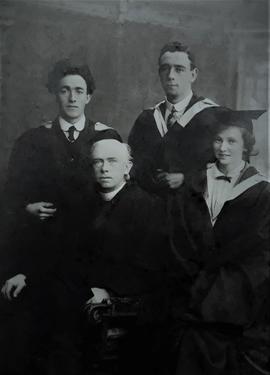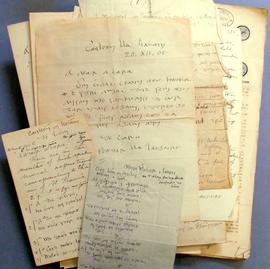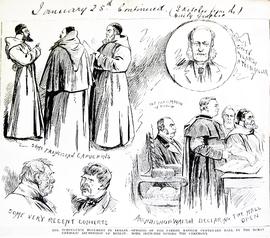A view of the Spanish Arch, an historical landmark in Galway city, in about 1950.
A view of the original Abbey Theatre building in Dublin in about 1949. The Abbey Theatre was founded in 1904 by W. B. Yeats and Lady Augusta Gregory. In its early years, the theatre was closely associated with the writers of the Irish Literary Revival including Yeats, Gregory, John Millington Synge and Sean O’Casey.
A view of the Allied Irish Bank building at the corner of Westmoreland Street and College Street in Dublin in about 1950. A manuscript annotation on the reverse of the print reads 'Architectural Study, Dublin'.
Detail from the exterior of George's Street Arcade, a Victorian style red-bricked market building (opened in 1881) located on South Great George's Street in Dublin. A manuscript annotation on the reverse of the print reads 'Beauty in block at George's Street, Dublin'.
Letter from Eleanor Hull, 14 Stanley Gardens, Notting Hill Gate, London, to Fr. Richard Henebry. Hull refers to arrangements for a meeting with Henebry and to a story submitted to the Irish Texts Society for publication.
A clipping of an advertisement for Seán Ó Currín, ‘Scríbhne Risteird de Hindeberg’. The volume comprised an edited collection of Fr. Richard Henebry’s writings and speeches. It was was published by Browne and Nolan in Dublin in 1924.
Programme for the literary sessions organised by the Cork Young Men’s Society for November 1903 to April 1904. The speakers included Fr. Richard Henebry on ‘Irish Music’ (1 December 1903) and Fr. John Butler OSFC on ‘The work and homes of the early Irish Franciscans’ (23 February 1904).
A photographic print of Fr. Richard Henebry with three university graduates presumably in University College Cork. The print is by Guy & Co., Cork.
The subseries comprises a small collection of papers relating to the Irish scholar and writer An tAthair Peadar Ó Laoghaire (Peter O’Leary). Ó Laoghaire was a prominent Irish language activist and member of Conradh na Gaeilge (Gaelic League). He published numerous books and articles on a range of topics, including an autobiography (‘Mo Sgéal Féin’), the first drama in Irish (‘Tadhg saor’), original prose, Irish translations of the Gospels, and translations of medieval Irish texts. The collection includes his letters to Fr. Augustine Hayden OFM Cap. and Fr. Albert Bibby OFM Cap., two Capuchin friars who shared Ó Laoghaire’s enthusiasm for the promotion of the Irish language. This collection also includes some material relating to Ó Laoghaire’s published work, particularly clippings of his transcriptions and translations of Irish texts, and a manuscript draft of ‘An Craos-Deamhan’. Fr. Senan Moynihan OFM Cap. was interested in Ó Laoghaire’s career and sought to promote his contribution to the Irish language. He seemingly acquired most of this material for personal research. The Ó Laoghaire collection was later preserved among Moynihan’s personal papers.
Sem títuloNewspaper cuttings compiled by Fr. Paul Neary OFM Cap. (d. 20 June 1939) relating to the life and temperance campaign of Fr. Theobald Mathew OSFC. The majority of the cuttings and publications are from 1890 and relate to the commemorations of the centenary of the birth of Fr. Mathew. An alphabetical index to the newspaper clippings is extant at the front of the volume. The volume includes cuttings from the 'Belfast Morning News', 'Catholic Times', 'Daily Graphic', 'Evening Telegraph', 'Cork Examiner', 'Freeman’s Journal', 'Northern Whig' (Belfast), 'Temperance Record' (London), 'Weekly Herald', and 'Women’s Penny Papers'. The volume also includes illustrations of Father Mathew Memorial Hall, Church Street, Dublin, temperance demonstrations in Cork and Dublin, notable events and places associated with the life and work of Fr. Mathew, and the Father Mathew statue on Sackville Street, Dublin. Printed matter inserted in the volume includes flyers for the Grand National Celebration in honour of Father Mathew held in Cork, 8-10 Oct. 1890 (p. 101), the Rule book of the female branch of the Father Mathew Sacred Thirst Sodality (p. 149), and pastoral letters published by various Irish bishops marking the Father Mathew centenary (pp 163-70).
Sem título